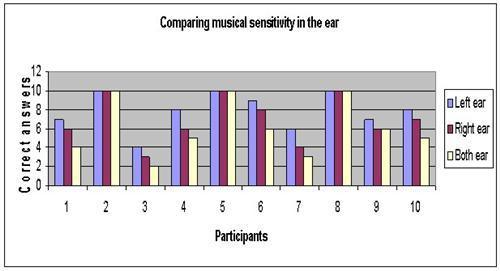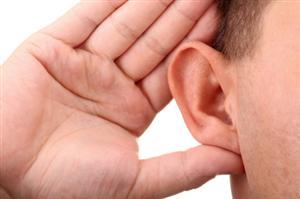| Complexity level: | 3 |
| Time required: | 1 day for preparation and experimentation |
| Safety concerns: |
Hypothesis
The participants will be able to recognize the notes better when using only the left ear.
Overview
Tone deaf
Tone deafness refers to a condition where a person is unable to distinguish between the different musical notes. Afflicted persons are not able to recognize the difference when 2 different musical notes are played. This inability is not caused by a lack of musical knowledge or training, but is instead caused by genetic inheritance or brain damage.
Tone deafness is a disability that is shown in music only. People who are tone deaf do not have a problem in recognizing the different intonations in human speech. This disability is also associated with the inability to follow musical rhythms and recognize songs.
Comparing right and left ears
Recent research has found that our left ears and right ears process sound in different ways. Our left ears are more inclined to listen to musical sounds while right ears are more attuned to sounds of speech. This is because the sound from the right ear is channeled to the left side of the brain while the sound from the left ear is channeled to the right side of the brain, and our left and right brains process sound information differently.
Scientific Terms
Materials
The materials required for the science fair project:
- A CD player
- A CD containing recordings of random musical notes
- A musical keyboard,organ, or piano
- A pair of earphones
- 1 sheet of small white labels
- 1 black marker
- 5 pairs of earplugs
Procedure
1. For this science fair project, the independent variable is listening to the musical note in the left ear only, right ear only and both ears. The dependent variable is the number of correct notes recognized by the participants. This is determined by comparing the musical notes that the participants listened to with the keyboard note selected by the participants. The constant (control variable) is the number of notes tested.
2. Select ten non-musically-trained participants to take part in this experiment.
3. Number all the keys on the musical keyboard with the white labels and marker.
4. Have all the participants wear earplugs in their right ears. Play 10 randomly selected musical notes recorded on the CD and allow participants to listen to the audio using their left ears only. After each note is played, ask the participants to select the key on the musical keyboard that corresponds to the musical note that was just played. Record the total number of correct keys selected by each participant.
5. Repeat step 4, but have the participants listen to the CD with the earplugs in their left ears, then with no earplugs. Record the results in a table, as shown below.

Results
The results show that the participants were able to recognize more musical notes when they listened to the CD using only their left ears. It was also noted that 3 participants were able to recognize less than 5 musical notes when listening with both ears, indicating that they might be tone deaf.
| Condition | Number of notes identified correctly | |||||||||
| 1 | 2 | 3 | 4 | 5 | 6 | 7 | 8 | 9 | 10 | |
| Left ear | 7 | 10 | 4 | 8 | 10 | 9 | 6 | 10 | 7 | 8 |
| Right ear | 6 | 10 | 3 | 6 | 10 | 8 | 4 | 10 | 6 | 7 |
| Both ear | 4 | 10 | 2 | 5 | 10 | 6 | 3 | 10 | 6 | 5 |
The above results were then plotted onto a graph, as shown below

Conclusion
The hypothesis that the participants would be able to recognize the notes better when using only their left ears has been proven to be true.
The discovery that our left ears are more attuned to musical sounds while our right ears are better for listening to human speech is important for speech and hearing rehabilitation. This discovery has helped doctors to improve speech and hearing in children born with hearing disabilities as well as to rehabilitate people suffering from hearing loss.
Also consider
Try to repeat the science fair project by comparing the ability to recognize musical tones among male and female participants and participants of different age groups.
The experiment can also be repeated to compare if the left ear is still more sensitive to musical notes if the participants are left-handed.
References
Tone deafness - http://en.wikipedia.org/wiki/Tone_deafness
Left ear vs right ear - http://soundmedicine.iu.edu/segment/939/Left-Ear-vs--Right-Ear
Speak to my right ear, sing to my left - http://www.abc.net.au/science/news/stories/s1197972.htm

